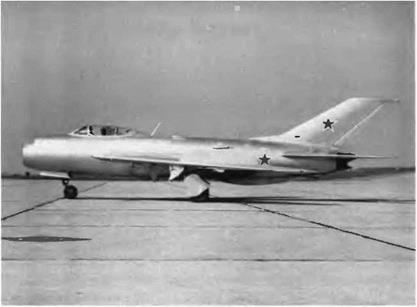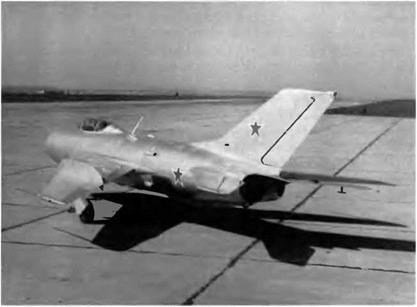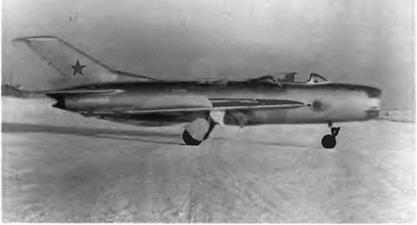MiG -1ЯР / SM 7
Another derivative of the SM-2, this tactical interceptor was designed for day, night, and bad weather use The SM-7 differed from the SM-9 in many points:
—it was fitted with the RP-1 radar linked to the ASP-5NM gunsight, an IFF interrogator, and a radar warning receiver
—the radio racks were rearranged, and the radar was housed separately in a more accessible bay
—armament was reduced to two NR-23 cannons in the wing roots, and the ammunition belts (up to 120 rpg) were placed in wing leading edge ducts
—from the start, it was expected that NR-30 cannons would replace the NR-23s
|
|
The SM-7/1, an interceptor developed from the SM-2, was equipped with the RP-1
radar.
|
|
The SM-7/1 as well as the SM-9/1 had a fixed stabilizer One of the two radio-altimeters is visible under the right wing
|
The SM-7/2 as well as the SM-9/3 had a slab tail plane. |
|
The slab tailplane or all-flying tail of the SM 7/2 at its maximum pitch-up deflection. |
|
The SM-7/2—the future MiG-19P—with all of its three airbrakes deployed. |
—two RO-57-8 rocket pods with eight ARS-57 rockets apiece could be attached to wing pylons, as well as two 760-1 (201-US gallon) underslung tanks
—the underslung tanks could be replaced by two additional rocket pods with sixteen ARS-57 rockets apiece —because of the radar antennae, the forward section of the fuselage had to be modified up to the no. 9 frame and lengthened by 360 millimeters (14.17 inches)
—the air intake ducts were reshaped accordingly, and their section was enlarged
—both wing tips were fitted with Pitot-static probes, the one on the right linked to the navigational instruments and the one on the left to all the others
—because of the changes made to the forward section of the fuselage, it was possible to widen the cockpit —the pilot had a curtain-type ejection seat whose height could be adjusted to three positions over a range of 120 mm (4.7 inches) —the seat back had a 16-mm-thick armor plate behind the rails of the ejection system, which were protected (as was the locking pin of the ejection pyrotechnic system) against shrapnel and even direct hits
—the control rods actuated by the column were moved to beneath the cockpit floor
—ventilation of the adjustable-area nozzle was improved by modifying the cooling air supplies
—the RSIU-3 VHF and the ARK-5 automatic direction finder were linked to a single antenna on the fuselage —the DGMK-5 gyroscopic compass and the ARK-5 ADF shared a common indicator on the instrument panel —the oxygen supply for the pilot was increased to five 2-1 (0.53-US gallon) spherical bottles
The first SM-7, powered by two Mikulin AM-9Bs (RD-9Bs) with rated thrust of 3,185 daN (3,250 kg st) each, rolled out of the factory in July 1954 and made its first flight under V. A. Nefyedov on 28 August. Factory tests lasted until 15 December; ОКБ pilots made forty-three flights for a total of twenty-five hours and thirty-six minutes. The aircraft was then moved to the Nil WS, where it was certified. It was mass-produced from 1955 and delivered to WS, PVO, and VMF units under the military designation MiG-19P.
Following the production of the MiG-19S with a slab tailplane, the OKB built the SM-7/2 in 1955. This second prototype was also equipped with a slab tailplane and had the same equipment as the SM-7. It was tested, certified, and mass-produced as well.
Development of the SM-7 and SM-9/1 was basically the work of A. G. Brunov, deputy chief constructor; V. A. Arkhipov, Yu. A. Korolyev, and A. N. Soshin, main constructors; and G. Ye. Lozino-Lozinskiy, R. A. Belyakov, K. N. Rozanov, A. A. Nefyedov, Ya. I. Seletskiy, and N. I. Andrianov, brigade heads.
Specifications
Span, 9 m (29 ft 6.3 in); fuselage length, 10.48 m (34 ft 4.6 in); height, 4.02 m (13 ft 2.3 in); wing area, 25 rrr’ (269 sq ft); empty weight, 5,468 kg (12,050 lb); takeoff weight, 7,384 kg (16,275 lb); takeoff weight with two 760-1 (201-US gal) drop tanks, 8,738 kg (19,260 lb); fuel, 1,700 kg (3,750 lb); wing loading, 295.4-349.5 kg/m2 (60.6-71.6 lb/sq ft); max operating limit load factor, 7.95.
Performance
Max speed, 1,370 km/h at 10,000 m (740 kt at 32,800 ft); 1,255 km/h at 14,700 m (678 kt at 48,200 ft); max speed without reheat, 1,083 km/h at 10,000 m (585 kt at 32,800 ft); max Mach number, 1.384 at 9,800 m (32,150 ft), 1.296 at 8,700 m (28,540 ft); max speed at 1,200 m (3,940 ft), 1,180 km/h (637 kt); climb to 10,000 m (32,800 ft) with afterburner light-up at 5,000 m (16,400 ft) in 1.85 min; to 15,000 m (49,200 ft) with afterburner light-up at 5,000 m (16,400 ft) in 3.8 min; climb to 10,000 m (32,800 ft) without afterburner in 2.25 min; to 15,000 m (49,200 ft) in 6.1 min; service ceiling with afterburner, 17,600 m (57,700 ft); without afterburner, 16,150 m (52,970 ft); with afterburner and two 760-1 (201-US gal) drop tanks, 16,000 m (52,500 ft); range, 1,474 km at 12,000 m (915 mi at 39,360 ft); with two 760-1 (201-US gal) drop tanks, 2,318 km (1,440 mi).















